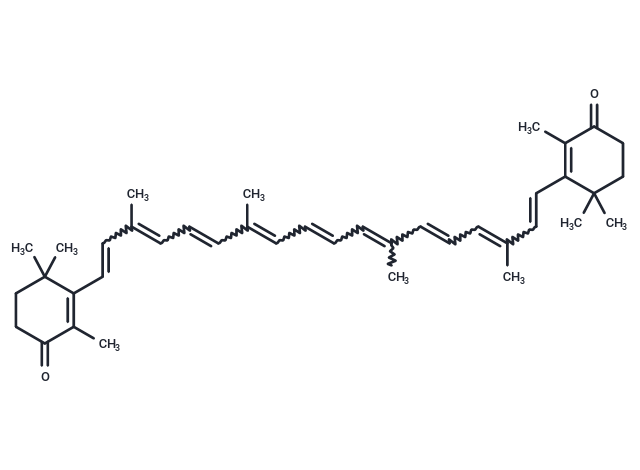Shopping Cart
- Remove All
 Your shopping cart is currently empty
Your shopping cart is currently empty

Canthaxanthin (E 161g) is a red-orange carotenoid that belongs to the xanthophyll group. This naturally occurring pigment is present in bacteria, algae and some fungi.

| Pack Size | Price | Availability | Quantity |
|---|---|---|---|
| 1 mg | $44 | In Stock | |
| 2 mg | $63 | In Stock | |
| 5 mg | $97 | In Stock | |
| 10 mg | $157 | In Stock | |
| 25 mg | $285 | In Stock | |
| 50 mg | $477 | In Stock | |
| 100 mg | $686 | In Stock | |
| 500 mg | $1,480 | In Stock |
| Description | Canthaxanthin (E 161g) is a red-orange carotenoid that belongs to the xanthophyll group. This naturally occurring pigment is present in bacteria, algae and some fungi. |
| In vitro | Canthaxanthin enrichment of LDL has the potential to protect cholesterol from oxidation. It possesses free radical scavenging and antioxidant properties (e.g., the induction of catalase and superoxide dismutase), along with immunomodulatory activity (e.g., enhancing the proliferation and function of immune-competent cells) and a critical role in gap junction communication (e.g., induction of the transmembrane protein connexin 43). |
| Alias | E 161g, all-trans-Canthaxanthin |
| Molecular Weight | 564.84 |
| Formula | C40H52O2 |
| Cas No. | 514-78-3 |
| Smiles | CC(C=CC=C(C)C=CC1=C(C)C(=O)CCC1(C)C)=CC=CC=C(C)C=CC=C(C)C=CC1=C(C)C(=O)CCC1(C)C |
| Relative Density. | 1.003 g/cm3 (Predicted) |
| Storage | keep away from direct sunlight,store under nitrogen | Powder: -20°C for 3 years | In solvent: -80°C for 1 year | Shipping with blue ice. | ||||||||||||||||||||||||||||||
| Solubility Information | DMSO: 33.89 mg/mL (60 mM), Sonication is recommended. | ||||||||||||||||||||||||||||||
Solution Preparation Table | |||||||||||||||||||||||||||||||
DMSO
| |||||||||||||||||||||||||||||||

Copyright © 2015-2025 TargetMol Chemicals Inc. All Rights Reserved.